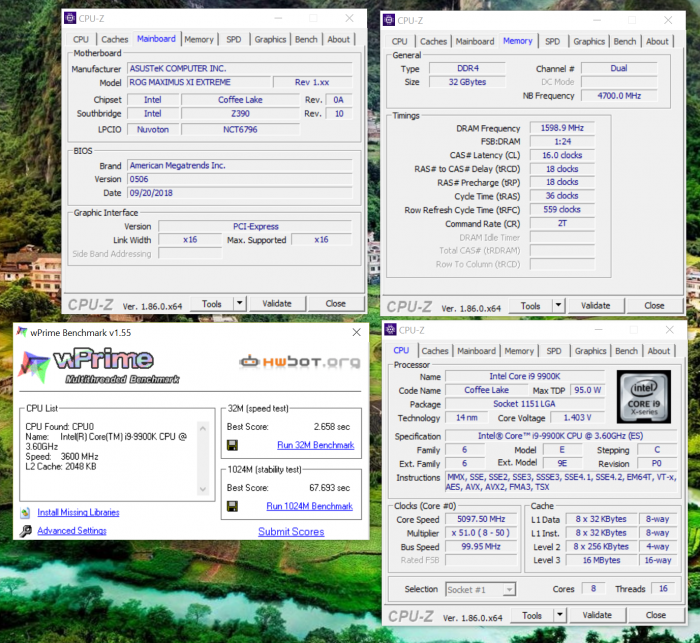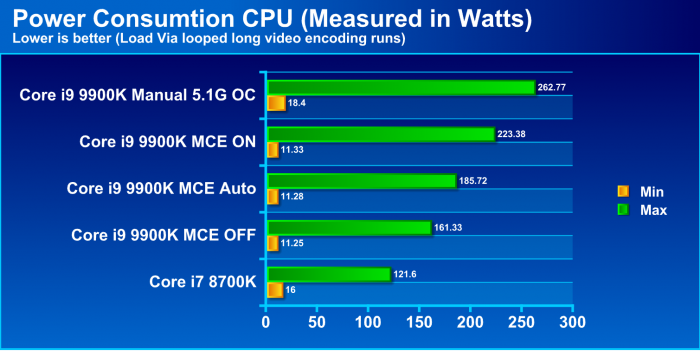Overclocking
Overclocking the 9900K is very similar to any other Coffee Lake CPU although depending on boards you use the options can vary wildly. One thing to note is that much like the 8086K which was really kind of pushed to its limit there’s not alto of headroom left on these chips. Add to that even though the solder TIM or STIM as Intel has labeled it, the chips still run quite hot when pushing them. Its simple physics, they stuffed two more cores into this small package so its 25% more chip to cool vs an 8700K and yes the TDP is 95W but that’s at the base clock. When we watched turbo take effect we saw power draw for the CPU swing up to the 160W range which as I’m sure you can imagine generates some serious heat.
We were able to get a fully stable 5.1GHz clock at 1.365VCore, however, the benefits were marginal at best as enabling MCE or Multi-Core enhancement or Enhanced Turbo or however it may be referenced depending on your board will run up to 5GHz on all cores anyways or close to it.
I am hoping future BIOS revisions and microcode updates can ease things up a bit and optimize capabilities as even with my 360mm AIO while it was not throttling it was taking north of 1.4V to get stable at 5.2GHz and while it may be in the ballpark of what’s considered reasonable I just don’t feel I would want to pump that much voltage all the time for a meager 100MHz gain.
Here you can see that with the overshoot by LVL 5 LLC I was playing a bit with voltage and offsets and was fully stable at 1.365-1.38VCore for all core 5.1GHz.
ASUS does have a new AI Overclocking utility within the BIOS that uses learning based on stress testing and quick adjustments based on presets from what the ASUS engineering team has learned form binning multiple chips which can reach really close to your overclock you may spend a significant amount of time setting up yourself. I did test it and it got to the same overclock I did albeit it padded the voltage a bit more than I needed at .015V over what I actually needed for full stability. This is likely due to the fact that they have to account for worst case silicon quality as well which means you always get a small overshoot depending on your chip quality.
Temperatures
For Thermals the 9900K is an interesting animal as it can get really hot really fast. then again we are packing more cores onto the already toasty 8700k in essence right?
Our thermal results when testing with MCE disabled was well manageable,

We test with a real-world load by running large video encodes in succession to fully burn in the CPU. We do not use artificial stress tests such as Prime95 or IBT as those are simply not indicative of a real-world loading scenario and can also potentially hard hardware due to overdrawing components and potential thermal overrun.
Now as you can see even with MCE enabled fully it tops out at 4.8G on all cores which are well manageable although I will state again that MCE tends to take the worst case scenario route and pushes more voltage than you need in reality. This means higher overall thermals but these were well managed by the Asetek 360mm AIO. One thing worth noting is that manual overclock which simply does not give much fruit for your efforts here (at least yet) are almost not worth it as you are pushing more potential volts and heat for what I would consider marginal gains when enabling MCE does the job and stays within a predefined voltage curve somewhat specified by Intel.
It is also worth noting that if you have a weaker cooler or are air cooling I could see thermal overrun scenarios hitting much quicker and I will be testing that more as I test more boards.
Power Consumption
The power consumption of the 9900K goes from mild to wild with values ranging from 11.25W at idle to 260W+ (For the CPU alone) when pushed on the ASUS board.
Here as you can see, the power consumption can get pretty high which also explains the temp ramping in lockstep. Imagine if you are doing AVX loading that wattage wil raise by close to 30-40W in my experience.
 Bjorn3D.com Bjorn3d.com – Satisfying Your Daily Tech Cravings Since 1996
Bjorn3D.com Bjorn3d.com – Satisfying Your Daily Tech Cravings Since 1996














So you need yet another mb with a new, re-cooked intel only chipset… MMmmmm NO. Ive for the first gen AMD and I can put in after a new bios the 2nd gen core/16 thread ryzen and then I can put in the 3rd gen die shrink and speed up ryzen. So pass. For what Intel are charging you can buy the ryzen, mb and memory. And did you see the power and thermals needed once you go past 4.0ghz! Well my amd is sweet at 4 and Im happy ~ intel can again go broke as they have learnt nothing!
You do not need a new motherboard. The Z370 or other 300 series chipset will work just fine with it… We would recommend a newer 390 based board for pushing the limits of the 9900K though.
1. why are reviewers running super pi on this multicore chip? 2. why are we still doing single core benchmarks on workstation “like” chips? 3. all the benchmarks software ran on this chip favor and are written for intel. 4. you did not even attempt to put a TR 10 core in the mix. 5. this chip is not a ground up chip. 6. some of the conclusions to the review, i agree with.
The review clearly states the feelings toward the “value proposition” of the 9900K as far as the benchmarks being Intel focused, this is a complete fallacy. These benchmarks are static vendor agnostic ways of interpreting IPC performance differences. There is no 10 core TR chip… and I see no point comparing a HEDT platform to a mainstream platform, that simply doesn’t make sense.
Either way you look at it, the introduction of the 9900K has actually helped more than hurt AMD.